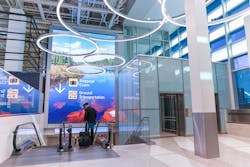Minneapolis-St. Paul International Airport (MSP) uses one content management system (CMS) to manage about 900 digital displays of various types – from overhead roadway signs to baggage information displays.
According to Eduardo Valencia, CIO, Metropolitan Airports Commission (MSP's owner and operator), the inspiration to consolidate display information systems came from the Minnesota Twins. Valencia is a member of the Large Venue Tech Collective based in the Twin Cities and so is Minnesota Twins Senior VP of Technology John Avenson, who at one meeting talked about the CMS of the digital assets at the Twins’ stadium.
“You really know when something good is happening by the combination of what you’re seeing and what you’re hearing, on top of what you’re witnessing in the stadium,” said Valencia, who learned others in the group were using similar tools.
“Although we’re not scoring home runs, we do have the opportunity to manage an experience.”
Taking a play from the Twins’ playbook, Valencia sought a digital display CMS that would allow better IT management and enable business units within the airport to control their own content and share content across displays. With these goals in mind, the airport aimed to create a better passenger experience, and, it did. In the J.D. Power 2022 North America Airport Satisfaction Study, Minneapolis-Saint Paul International Airport ranked highest in passenger satisfaction among mega airports.
Technology Goals
From a technology management perspective, Valencia said the goal was to eliminate individual display systems and move them to a more robust environment by having one enterprise system.
Information systems have been converged inside and outside the terminal. Any display can now show information about roadway traffic, wayfinding, ticketing, check-in, passenger flow, wait times, flights, baggage, and TSA and Customs and Border Protection requirements, as well as advertising.
With fewer “moving parts” and eliminating the variability that comes with multiple systems, Valencia said the benefits have been increased up time and reliability with the displays being monitored and managed through monitoring software.
Cross asset utilization encourages the use of consistent messaging and affords efficiency.
In airports, you sort of have these “fiefdoms,” Valencia said. In other words, he said, “Those displays are only for this purpose.”
Picture a bank of many monitors displaying flight information at the beginning of the day. As there are fewer flights left in the day, less space is needed for flight information, making room for other content. The CMS can dynamically use that free space and offer art or advertising, for instance.
“We wanted to leverage all our digital displays in a cohesive integrated way to try to then open up that digital canvas to business (units) for them to use, basically be able to put any message, from any source, data or not, anywhere, any time,” he said.
Or, if a vehicle on the roadway in front of the airport exceeds the height limit of the overpass, all the signs in the path of the vehicle can change to direct the vehicle away from that overpass.
“We wanted to enable business units to control content dynamically and be able to do that at the press of a button,” he said, which means they no longer need to go through IT.
An MSP business-led governance group, initially led by IT and now led by the marketing and communications and passenger experience teams, was formed to explore the opportunities created by the new technology. The group includes representatives from all the business units, who traditionally have used displays. They include operations and airport police.
Not all displays within the airport are part of the CMS. “We don’t manage concessions displays,” he clarified. “That’s on purpose because there’s probably not a lot of cross utilization. We also don’t manage any legacy carrier, non-common use displays.”
In the gate hold area are about 40 displays with TV only now that Valencia said will be converted to the CMS and there are a handful of assets included in advertisement contracts that will be added to the CMS after the contracts expire.
“Anything new that is a digital display follows this strategy, so it’s managed as one collective and it is part of the content management system,” Valencia said.
Behind the Scenes
MSP knew what it was trying to achieve. The question was how.
“Like many airports, MSP had a very siloed approach to digital signage,” said digital signage expert Neil Bron Chatwood of Omnivex Corporation. “Digital signage is traditionally screens on a wall serving a single purpose. Our products enable any content, on any screen, at any time. We also bridge the passenger-owned technology gap. Moving beyond screens on a wall to passenger smartphones and smart TVs”
Traditionally, airport digital signage systems were not interconnected. Each data source had its own information display systems (IDS).
“That’s where a lot of airports currently are and where MSP were 5 years ago,” Chatwood said.
Roughly 10 years ago, he said big data was all the rage. “Big data forced organizations to look at their data infrastructure, assess how unwieldy it was and say we need to get our hands around this, unify our data and bring it into a single layer.”
Omnivex, a software development firm, has been helping with real-time data for over 30 years, and provides a visual communications platform.
“Screens can do whatever we want, any time of the day, regardless of where it’s positioned in the airport. The data’s unified, all the assets are unified, which gives us ultimate flexibility throughout the airport.” he said, adding the industry needs to move away from thinking one screen serving only one purpose.
Connecting people to information and extending it for a broader purpose is the role of the digital signage system, said Omnivex President Chris Devlin, adding, “Done properly, they’re some of the most connected systems in the world.”
They’re cross brand, cross department, through a whole facility, he said, “So it really is a digital experience platform.”
Chatwood continued, “All communications, marketing, advertising, every bit of signage that is out in the world is fundamentally coaching a human to make a decision.
“A key benefit of digitizing signage is the ability to change that information, that decision-making impulse as many times as desired. Hyper-contextual information drives contextual decision making. We’re not just putting something out in the world and hoping it lands. We know the demographic, the people who are looking at these signs, they’re looking for that information as opposed to simply being fed that information.”
Devlin added the connectivity provides not only better customer service but also a better experience for everyone working at the airport.
“We can connect those (disparate) systems and present any mix or blend of that information onto any screen,” he said. “It’s that ability to control the narrative and to wield converged information to service everybody in that facility better. The display technology is beautiful today, the connectivity is ubiquitous, lets harness those strengths to literally improve everyone’s experience. All people in the airport will be better informed, make better decisions and they will enjoy their travel and work experiences more as a result.”
As a CMS software vendor, Chatwood said, “We are one part of an ecosystem. A digital signage project, especially an overhaul is not an easy task.” That’s especially true in an airport, where hours for downtime are extremely limited.
“We have to be realistic about what the lift is,” he said. Also important is knowing to what extent the airport wants to work along with Omnivex and the systems integrator.
“We are deeply involved with our systems integrators, our airport user base and we’re working together as a cohesive project team to make sure it’s a reasonable lift, it’s achievable and the timeframe is realistic as well.”
For MSP, the systems integrator was Radiant Technology Group.
Work done by Radiant Technology began with consulting, including a multi-year vision and implementation plan, said Doug Freutel, Radiant Technology VP of innovation and visionary. Freutel reports moving MSP’s various digital assets onto one platform took about four years and complete consolidation was achieved this year.
He describes MSP’s vision not as digitization (analog to digital) but as a digital transformation (completely transforming an experience using digital).
“We can actually use data to recognize who the passenger is, then based on that intelligence, we can help them drive a better experience,” he said.
If arriving passengers have been on a long fight, they might need to use the restroom, get something from concessions, claim their baggage or connect to another flight.
“The more data that we’re able to get within that, the better we can drive that outcome,” Freutel said. “When passengers get off the plane, they’re not going to be barraged with a tons of digital signs and overwhelmed with information. We can actually have fewer signs and be able to know with some intelligence what that passenger is trying to accomplish and make their journey much more impactful.”
Using Pulse, Radiant’s proprietary digital signage monitoring software, the airport and Radiant now monitor the entire digital display ecosystem.
“We integrated into the ticketing system, which is their Service Now platform,” Freutel said. If a screen shuts off, for instance, an alert is generated in Service Now. The airport’s IT help desk provides initial support. If more help is needed, Radiant has remote management capabilities, and with critical systems, engineers respond within 30 minutes.
Radiant’s digital signage controller (a tool to enhance workflows for departments and vendors and airlines to be able to be much more efficient in managing the display systems that impact the different parts of the passenger journey) for MSP has been named a 2022 Digital Signage Experience Award finalist. The awards program recognizes companies from around the world whose “digital signage installations and campaigns challenge existing standards and drive the industry forward.”






